

|
| weblog/wEssays archives | home | |
|
The American House and Frank Lloyd Wright (May 27, 2006) 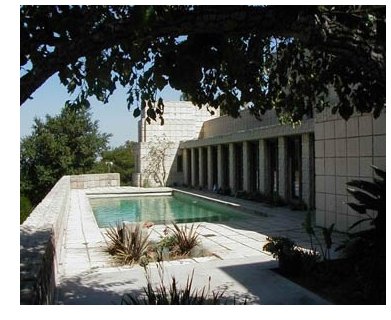 Frank Lloyd Wright did not design a housing "style;" he designed a new American identity
rooted in a landscape of democracy. In the current obsession with housing as an
investment vehicle and a ticket to gobs of free money, it's worth recalling that a house
is not just a repository of cash value or even shelter; it is also a space which nurtures or
deadens identity and either wastes or employs limited resources. Wright understood this in
a way which has largely been lost in our design-deprived era.
Frank Lloyd Wright did not design a housing "style;" he designed a new American identity
rooted in a landscape of democracy. In the current obsession with housing as an
investment vehicle and a ticket to gobs of free money, it's worth recalling that a house
is not just a repository of cash value or even shelter; it is also a space which nurtures or
deadens identity and either wastes or employs limited resources. Wright understood this in
a way which has largely been lost in our design-deprived era.
Like many other larger-than-life people, Wright was a mass of sometimes prickly or even unlikeable contradictions. Known for an almost comically monstrous ego, he nonetheless produced a body of work and a philosophy which is uniquely American in vigor, scope and depth. How egotistical, you ask? A young couple once wrote to Wright, inquiring about the cost of his services. They heard nothing for months and then received a call one day from an imperious-sounding male: "This is your architect speaking." It was pure Wright; never mind responding to the inquiry about costs; my schedule (and bank account) has been cleared, and I will now design your house, regardless of your wishes. 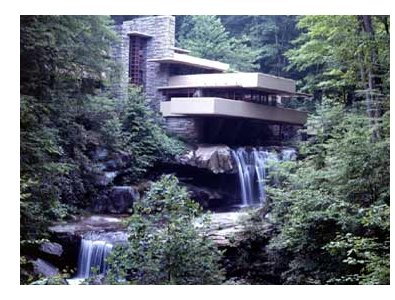 History has not always been kind to his buildings, either; many leak or suffer structural
problems; the
Ennis House (shown above) in the Los Feliz district of Los Angeles is in the midst of a multi-million dollar
structural rehab, and
Falling Water, perhaps Wright's most famous house, recently underwent a complex
structural renovation.
History has not always been kind to his buildings, either; many leak or suffer structural
problems; the
Ennis House (shown above) in the Los Feliz district of Los Angeles is in the midst of a multi-million dollar
structural rehab, and
Falling Water, perhaps Wright's most famous house, recently underwent a complex
structural renovation.
Given that these homes were designed and built in the 20s and 30s, before structural engineers fully understood how to calculate all the forces placed on buildings, it may be unfair to place the blame entirely on Wright's unconventional designs and construction techniques. Still, it is fair to say that his smaller, more conventionally constructed "Usonian" houses have not required the enormously expensive repairs which have plagued some of his larger, stretching-the-envelope projects. 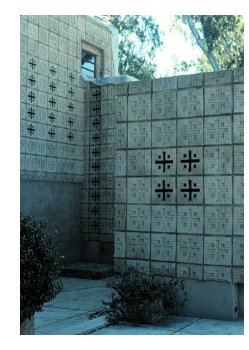 Wright was dedicated not just to large-scale projects for wealthy clients but to a vision
of affordable, beautifully designed homes for average-income people, houses he dubbed
"Usonian" (a derivative of "U.S."). As a result, he experimented at great length with cheap,
easy-to-build materials, most notably concrete blocks, as shown here in a wall of his
La Miniatura house in Pasadena, California.
Wright was dedicated not just to large-scale projects for wealthy clients but to a vision
of affordable, beautifully designed homes for average-income people, houses he dubbed
"Usonian" (a derivative of "U.S."). As a result, he experimented at great length with cheap,
easy-to-build materials, most notably concrete blocks, as shown here in a wall of his
La Miniatura house in Pasadena, California.
One of my favorite Wright stories is his own account of discovering that ancient Chinese and Japanese artists had developed the tenets of his "organic architecture" long before he himself set pen to paper. This degradation of his genius sent Wright into a deep funk until the happy thought occurred to him that as these past masters were not alive today, he was still the world's premier torch-carrier of "organic" design. What is "organic" architecture? Simply put, it is buildings which are integrated into, and draw inspiration from, the landscape in which they are sited. Further, the home's furnishings are designed into the house itself rather than purchased willy-nilly or changed out every few years as fashion dictates. 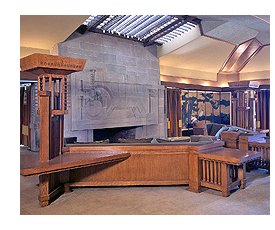 Here is an example from the Hollyhock House in Los Angeles. One of the charming features of
this living room is the small stream of water which meanders around the fireplace. On my
last visit some years ago, the rivulet of water was not running, but the concept was
dramatically and invitingly original.
Here is an example from the Hollyhock House in Los Angeles. One of the charming features of
this living room is the small stream of water which meanders around the fireplace. On my
last visit some years ago, the rivulet of water was not running, but the concept was
dramatically and invitingly original.
I cannot quite describe the profound influence these buildings had on me as a child. Can you vividly recall any houses you visited as a child? Can you relive the sense of awe and wonderment you felt? Did any house evoke such a powerful sense of mystery in you that the memory still burns hot in your mind? This is the largely unrealized power of great design; just entering a Wright house, especially a small Usonian one, is to feel welcomed and spiritually enlivened in a way which is incomprehensible to those who have known only bland, drywall-stucco-pressed sawdust-siding monstrosities. This is not an intellectual experience; it is a deeply emotional, visceral one which transforms your understanding of space and the great unrealized potential of housing to uplift the human spirit. 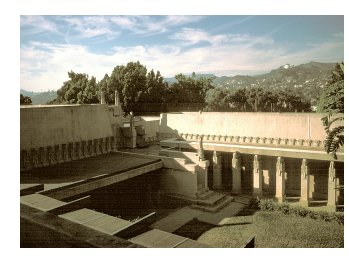 We lived in the Los Feliz area for several years in my childhood, and I would often gaze
up at the low, almost brooding Mayan fortress of the Ennis House. My elementary school
was located just below the
Hollyhock House, and my summer art classes
were held in the property's small guest house (circa 1963-64). As a 10-year old, I did not know about Wright,
or what made these buildings so memorably mysterious and attractive; but the buildings
work their magic perhaps more readily on children than on jaded (or more accurately, brainwashed)
adults.
We lived in the Los Feliz area for several years in my childhood, and I would often gaze
up at the low, almost brooding Mayan fortress of the Ennis House. My elementary school
was located just below the
Hollyhock House, and my summer art classes
were held in the property's small guest house (circa 1963-64). As a 10-year old, I did not know about Wright,
or what made these buildings so memorably mysterious and attractive; but the buildings
work their magic perhaps more readily on children than on jaded (or more accurately, brainwashed)
adults.
If you are not familiar with Wright's Usonian concept, then scroll through Matt Taylor's excellent site on Usonian houses. To quote just one paragraph: 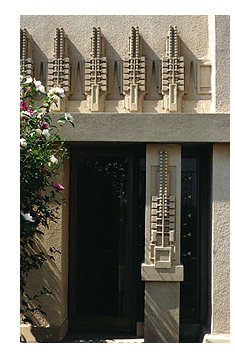
"One comment that Mr. Wright made again and again was 'until we have an organic culture we will never have an organic architecture.' His point is that architecture is the result of the choices individuals make and it expresses the culture they make up and in turn are influenced by. The Usonian house is not just another way to “style” a building - it is about a different way of living; a way that, today, is alien to the mainstream of our American culture. The usonian way is about relating differently to the Earth, to life and to all living beings - it is an integrated, natural life-style. Sustainable, evolving, sensory, engaging - it is to be surrounded by beauty and to live in harmony."To step into a Usonian house--small, inexpensively constructed of basic materials--is to understand how far we have drifted from being a sustainable, spiritually enriching society, and how distant the McMansions and subdivisions of today are from the profoundly democratic and practical vision made real in Wright's Usonian homes. For more on this subject and a wide array of other topics, please visit my weblog. copyright © 2006 Charles Hugh Smith. All rights reserved in all media. I would be honored if you linked this wEssay to your site, or printed a copy for your own use. |
||
| weblog/wEssays | home |